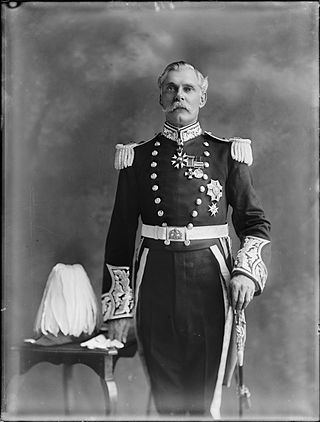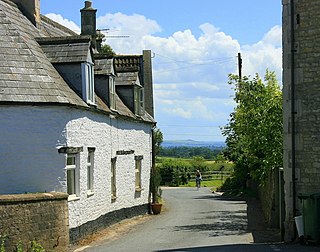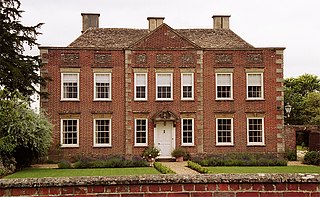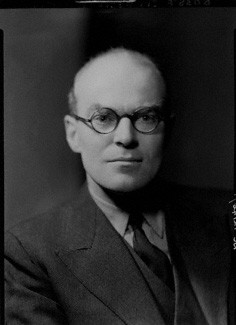
Wiltshire is a ceremonial county in South West England. It borders Gloucestershire to the north, Oxfordshire to the north-east, Berkshire to the east, Hampshire to the south-east, Dorset to the south, and Somerset to the west. The largest settlement is Swindon, and Trowbridge is the county town.

Lacock is a village and civil parish in the county of Wiltshire, England, about 3 miles (5 km) south of the town of Chippenham, and about 3.7 miles (6.0 km) outside the Cotswolds area. The village is owned almost in its entirety by the National Trust and attracts many visitors by virtue of its unspoiled appearance.

Avebury is a village and civil parish in Wiltshire, England. The village is about 5.5 miles (9 km) west of Marlborough and 8 miles (13 km) northeast of Devizes. Much of the village is encircled by the prehistoric monument complex also known as Avebury. The parish also includes the small villages of Avebury Trusloe and Beckhampton, and the hamlet of West Kennett.

John Poynder Dickson-Poynder, 1st Baron Islington,, born John Poynder Dickson and known as Sir John Poynder Dickson-Poynder from 1884 to 1910, was a British politician. He was Governor of New Zealand between 1910 and 1912.

Corsham is a historic market town and civil parish in west Wiltshire, England. It is at the southwestern edge of the Cotswolds, just off the A4 national route. It is 28 miles (45 km) southwest of Swindon, 20 miles (32 km) east of Bristol, 8 miles (13 km) north-east of Bath, and 4 miles (6 km) southwest of Chippenham.

Hartham Park is a Georgian manor house in Wiltshire, England, about 1+1⁄4 miles (2.0 km) north of the town of Corsham. Originally designed by James Wyatt, and set today in 50 acres (20 ha), it has within its grounds a stické tennis court. The house and nearby buildings were developed as a private business park in the late 1990s, although the house retains its Georgian facade and look.

Corsham Court is an English country house in a park designed by Capability Brown. It is in the town of Corsham, 3 miles (5 km) west of Chippenham, Wiltshire, and is notable for its fine art collection, based on the nucleus of paintings inherited in 1757 by Paul Methuen from his uncle, Sir Paul Methuen, the diplomat. It is currently the home of the present Baron Methuen, James Methuen-Campbell, the eighth generation of the Methuens to live there.

Box is a large village and civil parish within the Cotswolds Area of Outstanding Natural Beauty in Wiltshire, England, about 3 miles (5 km) west of Corsham and 5 miles (8 km) northeast of Bath. Box also falls in the easternmost part of the Avon Green Belt. Besides the village of Box, the parish includes the villages of Ashley and Box Hill; Hazelbury manor; and the hamlets of Alcombe, Blue Vein, Chapel Plaister, Ditteridge, Henley, Kingsdown, Middlehill, and Wadswick. To the east the parish includes much of Rudloe, formerly a hamlet but now a housing estate, and the defence establishments and related businesses on the site of the former RAF Rudloe Manor.

Avebury Manor & Garden is a National Trust property consisting of a Grade I listed early-16th-century manor house and its surrounding garden. It is in Avebury, near Marlborough, Wiltshire, England, in the centre of the village next to St James's Church and close to the Avebury neolithic henge monument.

Atworth is a village and civil parish in west Wiltshire, England. The village is on the A365 road between Melksham and Box, about 2.5 miles (4 km) northwest of Melksham and 4 miles (6 km) northeast of Bradford on Avon. The hamlet of Purlpit lies east of Atworth village, and in the south of the parish are the small village of Great Chalfield and the hamlet of Little Chalfield.

RAF Rudloe Manor, formerly RAF Box, was a Royal Air Force station north-east of Bath, England, between the settlements of Box and Corsham, in Wiltshire. It was one of several military installations in the area and covered three dispersed sites. Parts of the site are now used by Defence Digital within the MoD Corsham complex; other areas are vacant and some have been sold, including the 17th-century manor house, Rudloe Manor.

Monkton Farleigh is a village and civil parish in west Wiltshire, England, on high ground 3 miles (5 km) northwest of Bradford-on-Avon, and a similar distance east of the city of Bath. The parish includes the hamlets of Farleigh Wick and Pinckney Green. In the west and northwest the parish is bounded by Somerset.

Great Coxwell Barn is a Medieval tithe barn at Great Coxwell, Oxfordshire, England. It is on the northern edge of the village of Great Coxwell, which is about 9 miles (14 km) northeast of Swindon in neighbouring Wiltshire.

Hilmarton is a village and civil parish in North Wiltshire, in the west of England. The village lies on the A3102 between the towns of Calne and Wootton Bassett, and 2 miles (3.2 km) south of Lyneham. The parish includes the village of Goatacre and the hamlets of Catcomb, Clevancy, Highway and New Zealand.

Bradenstoke Priory was a medieval priory of Augustinian canons regular in the village of Bradenstoke, Wiltshire, England. Its site, in the north of the county about 1+1⁄2 miles (2.4 km) west of Lyneham, is on a ridge above the south side of Dauntsey Vale. In the 1930s the property was purchased by William Randolph Hearst and some of its structures were used by him for the renovation of St Donat's Castle near Llantwit Major, Wales.

Calstone Wellington is a small village and former parish in Wiltshire, England, about 2.5 miles (4 km) south-east of Calne and now part of the civil parish of Calne Without. The village has a 15th-century church.

Tockenham is a village and civil parish in north Wiltshire, England. The village is about 1.2 miles (1.9 km) east of Lyneham and 3 miles (5 km) southwest of the town of Royal Wootton Bassett. The parish includes the hamlet of Tockenham Wick.

Lacock, England was first mentioned in the Domesday Book in 1086 with a population of less than 200, two small mills and a vineyard. The village's main attraction, Lacock Abbey, was founded on the manorial lands by Ela, Countess of Salisbury and established in 1232; in the reign of Henry III. Lacock was granted a market and developed a thriving wool industry during the Middle Ages. Reybridge, and a packhorse ford, remained the only crossing points of the River Avon until the 17th century.

MOD Corsham is a Ministry of Defence establishment located between the towns of Corsham and Box in Wiltshire, England. Since 1998 the site's principal activities concern British Armed Forces and MOD information and communications technology and information warfare.

Sir Felix John Morgan Brunner, 3rd Baronet was a British Liberal Party politician and business owner. He was the maternal uncle of Katharine, Duchess of Kent.





















